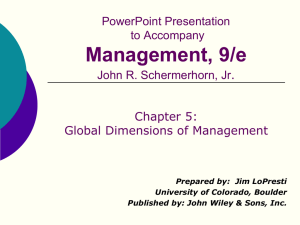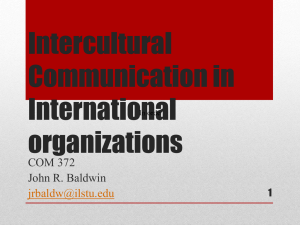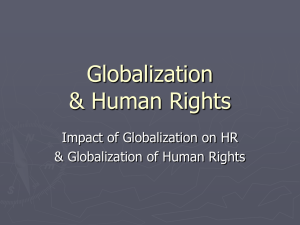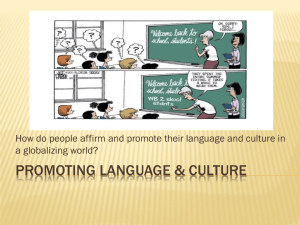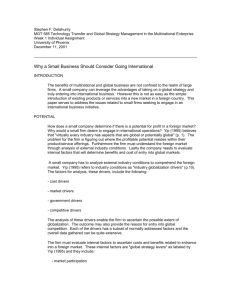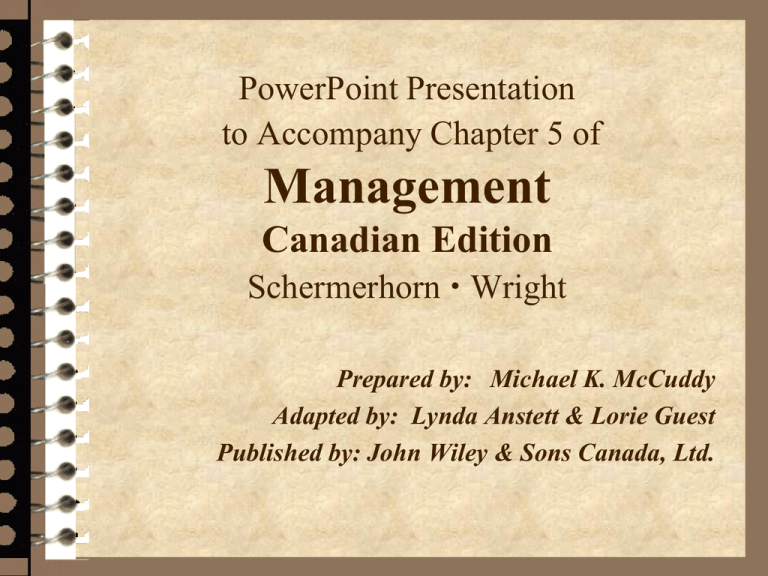
PowerPoint Presentation
to Accompany Chapter 5 of
Management
Canadian Edition
Schermerhorn Wright
Prepared by: Michael K. McCuddy
Adapted by: Lynda Anstett & Lorie Guest
Published by: John Wiley & Sons Canada, Ltd.
Planning Ahead — Chapter 5 Study Questions
What are the international management challenges of
globalization?
What are the forms and opportunities of international
business?
What are multinational corporations and what do they do?
What is culture and how does it relate to global diversity?
How do management practices and learning transfer across
cultures?
Management - Chapter 5
2
Study Question 1: What are the international
management challenges of globalization?
Key concepts in the challenges of
globalization:
– Global economy
– Globalization
– International management
– Global manager
Management - Chapter 5
3
Study Question 1: What are the international
management challenges of globalization?
Europe
– European Union (EU)
• Political and economic
alliance European
countries that agreed to
support mutual economic
growth
• Expanding to at 22
member countries with
375 million consumers
Management - Chapter 5
4
Study Question 1: What are the international
management challenges of globalization?
The Americas
– North American Free Trade
Agreement (NAFTA)
• Agreement for free flow of
goods and services
between the Canada,
Mexico, and United States
– Free Trade of the Americas
(FTAA) — Alaska to Chile
— is a possibility
Management - Chapter 5
5
Study Question 1: What are the international
management challenges of globalization?
Asia and the Pacific
Rim
– Economic power of
China and Japan
– Growth in other Pacific
Rim countries
– Asian countries
represent a third of the
global marketplace
Management - Chapter 5
6
Study Question 1: What are the international
management challenges of globalization?
Africa
– Increased attention to stable countries
– Beckons international business
– South African Development
Community (SADC) links 14
countries in trade and economic
development
Management - Chapter 5
7
Figure 5.1 Africa, continent of
opportunity.
Management - Chapter 5
8
Study Question 2: What are the forms and
opportunities of international business?
Reasons for engaging in international
business:
– Profits
– Customers
– Suppliers
– Capital
– Labor
Management - Chapter 5
9
Study Question 2: What are the forms and
opportunities of international business?
Market entry strategies involve the sale of goods
or services to foreign markets but do not require
expensive investments.
Types of market entry strategies:
– Global sourcing
–
–
–
–
Exporting
Importing
Licensing agreement
Franchising
Management - Chapter 5
10
Figure 5.2 Common forms of international business—from
market entry to direct investment strategies.
Management - Chapter 5
11
Study Question 2: What are the forms and
opportunities of international business?
Direct investment strategies require major
capital commitments but create rights of
ownership and control over foreign
operations.
Types of direct investment strategies:
– Joint ventures
– Foreign subsidiaries
Management - Chapter 5
12
Study Question 2: What are the forms and
opportunities of international business?
Criteria for choosing a joint venture partner:
– Familiarity with your firm’s major business.
– Strong local workforce.
– Future expansion possibilities.
– Strong local market for partner’s own products.
– Good profit potential.
– Sound financial standing.
Management - Chapter 5
13
Study Question 2: What are the forms and
opportunities of international business?
Complications in the global business environment:
– Environment is complex, dynamic, and highly
competitive.
– Global business executives must deal with differences
in the environment of business in different countries.
– World Trade Organization resolves trade and tariff
disputes among countries.
– Protectionism can complicate global trading
relationships.
Management - Chapter 5
14
Study Question 3: What are multinational
corporations and what do they do?
A multinational corporation (MNC) is a business
with extensive international operations in more
than one foreign country.
Management - Chapter 5
15
Study Question 3: What are multinational
corporations and what do they do?
Mutual benefits for host country and MNC:
– Shared growth opportunities
– Shared income opportunities
– Shared learning opportunities
– Shared development opportunities
Management - Chapter 5
16
Study Question 3: What are multinational
corporations and what do they do?
Host country complaints about MNCs:
– Excessive profits
– Domination of local economy
– Interference with local government
– Hiring the best local talent
– Limited technology transfer
– Disrespect for local customs
Management - Chapter 5
17
Figure 5.3 What should go right and what can go
wrong in MNC-host country relationships.
Management - Chapter 5
18
Study Question 3: What are multinational
corporations and what do they do?
MNC complaints about host countries:
– Profit limitations
– Overpriced resources
– Exploitative rules
– Foreign exchange restrictions
– Failure to uphold contracts
Management - Chapter 5
19
Study Question 3: What are multinational
corporations and what do they do?
Ethical issues for MNCs:
– Corruption — illegal practices that further one’s
business interests.
– Sweatshops — employing workers at low wages for
long hours and in poor working conditions.
– Child labor — full-time employment of children for
work otherwise done by adults.
– Sustainable development — meeting current needs
without compromising future needs.
Management - Chapter 5
20
Study Question 4: What is culture and how
does it relate to global diversity?
Culture
– The shared set of beliefs, values, and patterns of
behavior common to a group of people.
Culture shock
– Confusion and discomfort a person experiences in an
unfamiliar culture.
Ethnocentrism
– Tendency to consider one’s own culture as superior to
others.
Management - Chapter 5
21
Study Question 4: What is culture and how
does it relate to global diversity?
Stages in adjusting to a new culture:
– Confusion
– Small victories
– The honeymoon
– Irritation and anger
– Reality
Management - Chapter 5
22
Study Question 4: What is culture and how
does it relate to global diversity?
Popular dimensions of culture:
– Language
• Low-context cultures and high-context cultures
– Interpersonal space
– Time orientation
• Monochronic cultures and polychronic cultures
– Religion
– Contracts and agreements
Management - Chapter 5
23
Study Question 4: What is culture and how
does it relate to global diversity?
Values and national cultures (Hofstede):
– Power distance
– Uncertainty avoidance
– Individualism-collectivism
– Masculinity-femininity
– Time orientation
Management - Chapter 5
24
Figure 5.4 How countries compare on
Hofstede’s dimension of national culture.
Management - Chapter 5
25
Study Question 4: What is culture and how
does it relate to global diversity?
Understanding cultural differences (Trompenaars):
– Relationships with people:
•
•
•
•
•
Universalism versus particularism
Individualism versus collectivism
Neutral versus affective
Specific versus diffuse
Achievement versus prescription
– Attitudes toward time — sequential and synchronic
views.
– Attitudes toward environment — inner-directed and
outer-directed cultures.
Management - Chapter 5
26
Study Question 5: How do management practices
and learning transfer across cultures?
Comparative management
– How management systematically differs among
countries and/or cultures.
Global managers
– Need to successfully apply management
functions across international boundaries.
Management - Chapter 5
27
Study Question 5: How do management practices
and learning transfer across cultures?
Planning and controlling
– Complexity of international environment makes
global planning and controlling challenging.
– Planning and controlling risks:
• Currency risk
• Political risk
Management - Chapter 5
28
Study Question 5: How do management practices
and learning transfer across cultures?
Organizing and leading
– Multinational organization structures
• Global area structure
• Global product structure
– Staffing international operations
• Competent locals
• Expatriates
Management - Chapter 5
29
Figure 5.5 Alternative multinational
structures for global operations.
Management - Chapter 5
30
Study Question 5: How do management practices
and learning transfer across cultures?
Are management theories universal?
– North American management theories may be
ethnocentric.
• Participation and individual performance are not
emphasized as much in other cultures.
– Not all Japanese management practices can be
applied successfully abroad.
Management - Chapter 5
31
Study Question 5: How do management practices
and learning transfer across cultures?
Global organizational learning:
– Companies can and should learn from each other.
– Readiness for global organizational learning varies
based on managerial attitudes.
• Ethnocentric attitudes
• Polycentric attitudes
• Geocentric attitudes
– Be alert, open, inquiring, but always cautious.
Management - Chapter 5
32
COPYRIGHT
Copyright © 2007 John Wiley & Sons Canada, Ltd. All rights
reserved. Reproduction or translation of this work beyond that
permitted by Access Copyright (The Canadian Copyright Licensing
Agency) is unlawful. Requests for further information should be
addressed to the Permissions Department, John Wiley & Sons
Canada, Ltd. The purchaser may make back-up copies for his or her
own use only and not for distribution or resale. The author and the
publisher assume no responsibility for errors, omissions, or damages
caused by the use of these programs or from the use of the
information contained herein.

